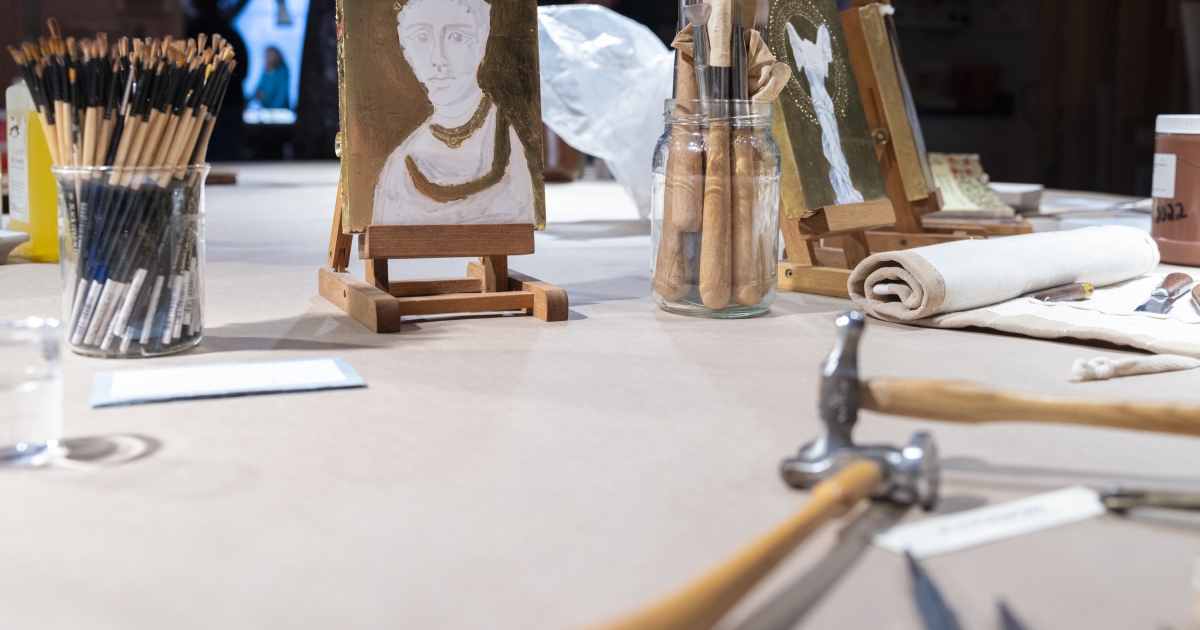
Recently, Buffalo Toronto Public Media received a grant for an episode of its original series, Let’s Go!, which guides young, curious learners through virtual field trips, to accompany the screening of a new, two-part, four-hour documentary titled Leonardo da Vinci, directed by Ken Burns, Sarah Burns, and David McMahon (a 1994 graduate of Clarence High School). The episode, titled The Underappreciated Work of Art Conservators, features Buffalo State University’s Patricia H. and Richard E. Garman Art Conservation Department. The Let’s Go episode is available on the Buffalo Toronto Public Media YouTube channel and PBS LearningMedia. The Ken Burns documentary will air November 18 and 19 from 8:00 to 10:00 p.m. and is available on PBS, PBS.org, and the PBS app.
We caught up with Meredeth Lavelle, program manager of the Garman Art Conservation Department, to learn more about the script development process, the on-campus filming day, and more.
How did the Garman Art Conservation Department become involved with Let’s Go?
The department was a natural tie-in. Da Vinci’s Last Supper was famously conserved, and our students learn to conserve paintings, in addition to gaining hands-on experience with historical methods, such as making their own panel paintings in the Renaissance tradition. One of the executives at Buffalo Toronto Public Media brought up my name to the group working on this project, and everything fell into place after an initial meeting. The first step was writing a grant application to get the funding, so I helped with the language to make a strong case for including the department. We were very fortunate to have this chance to showcase the department and campus.
What was your role throughout the script development process?
I had several meetings with producers and writers starting in February 2024. We talked about the goals of the project and what we could do to make connections to da Vinci. The producer was fantastic about wanting to get things right and tell our story accurately. I pointed him to some conservation literature and websites to help him become familiar with the field and answered a lot of questions along the way. The producers wrote the script, but I was able to give feedback, along with a few faculty members. They did a great job portraying the department and what we do. Our department does more than paintings conservation—we also do paper, objects, book, and photo conservation—and I wanted to make sure people knew that. The producers made sure that was communicated, which I appreciated.

Meredeth Lavelle
Tell us about the filming experience.
One of the producers came to campus over the summer and toured the space so we could get ideas on where best to film, and then, in September, Buffalo Toronto Public Media came to film in the department for the entire day. They set up around 7:30 a.m. and didn’t pack up until about 5:30 p.m. The producers and I wanted the focus of the episode to be on paintings conservation and conservation science, because art and science really tie in to da Vinci. The film crew focused most of their time in our paintings lab, in addition to our science lab and imaging studios. Students were excited to participate. The host of Let’s Go!, Chrisena, was fantastic. She made everyone feel at ease, had great questions, and was energetic and excited about our department.
Are there specific conservation techniques or insights showcased in the episode in which Buffalo State's Garman Art Conservation Department specializes?
The episode showed the very precise and exacting nature of the work our students do. It also gave a very good summary on how to get into the program and what the students study. A lot of the techniques and equipment highlighted showed a combination of science and art, which is what we had hoped for. They also highlighted the imaging and documentation lab, which is one of the hallmarks of our program.
What do you hope viewers will take away about the field of art conservation?
Let’s Go! is a kids’ show, but our episode was meant to me more of an “elevated” program for the entire family. Often, our students stumble upon the conservation field later in their college or professional careers and wish they had known about the field earlier. It is my hope that we might reach kids who maybe had never heard of the conservation field and might now consider it. We have been making strides over the past decade in diversifying the field of conservation and our program, so the bigger the audience we can get in knowing the field exists, the better. This program kind of gave everyone a sneak peek into a space on campus that is normally closed to visitors and showed the community that a world-renowned program is right here in Western New York.
Can you share any behind-the-scenes moments that viewers might be surprised to learn about?
I may be the only one, but I was amazed that a 10-hour filming day turned into a 10-minute episode! A ton of work went into those 10 minutes, but it was absolutely worth it. The episode was edited in less than two weeks, which was amazing. I couldn’t believe how fast they turned it around.
Anything else you’d like to add?
I am so thankful that everyone in the department was game for this. The students and faculty were really on board, and I could not have pulled any of this off without their help and interest in the project. It never would have worked without everyone’s cooperation and support.
Lead photo by Jesse Steffan-Colucci, Buffalo State photographer; headshot courtesy of Meredeth Lavelle.



